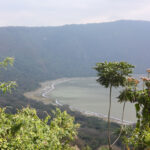
Mount Kilimanjaro National Park, located in northern Tanzania, is home to Africa’s highest peak, Mount Kilimanjaro. Standing at 5,895 meters (19,341 feet), Kilimanjaro is a dormant volcano with three volcanic cones: Kibo, Mawenzi, and Shira. The park, covering an area of 1,688 square kilometers, encompasses diverse ecosystems ranging from lush montane forests to alpine deserts, offering a unique trekking experience for adventurers from around the globe.
Activities
1. Trekking and Climbing:
The main attraction is trekking to the summit of Mount Kilimanjaro, with various routes like Marangu, Machame, Lemosho, Rongai, and Umbwe, each offering different levels of difficulty and scenic beauty.
2. Wildlife Viewing:
Although the primary focus is on the mountain, the park is home to diverse wildlife, including elephants, buffaloes, colobus monkeys, and various antelope species, which can be seen in the lower forests.
3. Bird Watching:
With over 250 bird species, the park is a haven for bird watchers. Look out for species like the Malachite Sunbird, African Pygmy Kingfisher, and Verreaux’s Eagle.
4. Cultural Visits:
Engage with the local Chagga people, who live on the southern and eastern slopes of Kilimanjaro. Learn about their customs, traditional farming methods, and folklore.
5. Nature Walks:
Explore the diverse flora of the park on guided nature walks, discovering unique plants like the giant groundsels and lobelias that are adapted to the high-altitude environment.
Best Time to Visit
January to March:
These months offer clear skies and relatively warm weather, making it an excellent time for trekking. It is also less crowded than the peak season.
June to October:
The dry season is the most popular time for climbing Kilimanjaro, with stable weather conditions and minimal rain. However, this period can be crowded.
April to May and November:
These are the rainy seasons, which make the trails slippery and more challenging. However, if you prefer fewer crowds and lush, green landscapes, this might be an ideal time.
FAQ
Is it safe to climb Mount Kilimanjaro?
Yes, climbing Kilimanjaro is generally safe, especially when done with experienced guides. It is important to acclimatize properly to avoid altitude sickness.
Do I need a visa to visit Tanzania?
Most visitors require a visa to enter Tanzania. Check with the Tanzanian embassy or consulate in your country for specific requirements.
What should I pack for a trek up Mount Kilimanjaro?
Essentials include layered clothing, a warm jacket, sturdy hiking boots, gloves, a hat, sunglasses, sunscreen, a sleeping bag, a headlamp, and a good-quality backpack. Don’t forget altitude sickness medication and a reusable water bottle.
Can I climb Mount Kilimanjaro independently?
No, climbing Kilimanjaro independently is not allowed. It is mandatory to be accompanied by registered guides and porters.
What accommodation options are available in the park?
Accommodation ranges from basic huts and campsites along the trekking routes to more comfortable lodges and hotels in nearby towns like Moshi and Arusha.
Nearby Attractions
Arusha National Park:
Located nearby, this park features diverse habitats and stunning views of Mount Meru.
Tarangire National Park:
Known for its large elephant herds and ancient baobab trees, this park offers excellent wildlife viewing opportunities.
Ngorongoro Conservation Area:
Famous for the Ngorongoro Crater, a massive volcanic caldera teeming with wildlife, this area is a must-visit.
Lake Manyara National Park:
Offers diverse landscapes and is known for its tree-climbing lions and large flocks of flamingos.
Conclusion
Mount Kilimanjaro National Park offers a unique blend of adventure, breathtaking scenery, and cultural experiences. Whether you’re an avid trekker aiming for the summit or a nature enthusiast exploring the lower slopes, the park promises an unforgettable journey in one of the most iconic landscapes in Africa.





